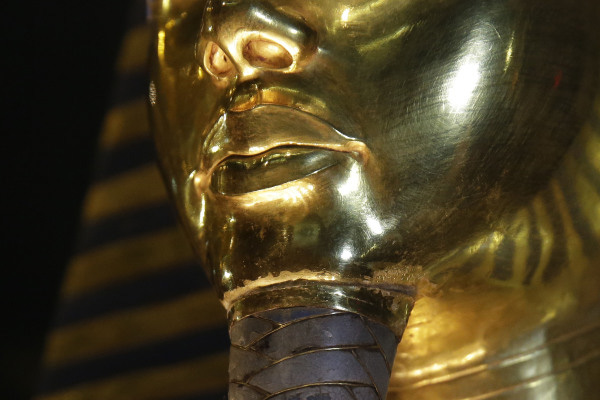To stop the brouhaha created in the last two days on the damaged golden mask of King Tutankhamun, Minister of Antiquities Mamdouh Eldamaty organised an international press conference Saturday at the Egyptian Museum in Tahrir Square.
Hundreds of journalists, photographers and media workers flocked to the museum to catch a glimpse of the mask, which newspapers reported had been glued back together when the blue and gold beard of the mask was broken during a cleaning process at the Egyptian Museum. Conservators reportedly glued the beard back on hurriedly with epoxy resin, damaging the artefact.
German conservator Chiristian Eckmann, who is an expert in metal restoration and is now in Egypt restoring Tutankhamun’s gold fragments, told reporters at the press conference that the mask is in a good condition of conservation. He asserted that no scratches were found on the mask, as shown in circulating photos in newspapers. Only one scratch is visible, which could not be determined as being recent. No change in the mask's colour occurred, and none of its precious stones were damaged. “I see that there was exaggeration in reports published in newspapers,” Eckmann told reporters.
“I inspected the mask today and there is no actual endangering of the mask. The measures that have been taken are reversible," Eckmann asserted.
Eckmann added that in August 2014, when lighting in the mask’s showcase was being repaired, "the mask was touched by the hand of the worker and the beard became loose." “This is normal,” Eckmann said, explaining that the damage was "due to the glue used during the first restoration of the mask in 1941."
Since its discovery in 1922 by Howard Carter, Eckmann said, the mask and the beard was transported to the Egyptian Museum as two separate pieces. In 1941, the beard was fixed to the mask. The mask and the beard was then displayed as one piece.

A detail of the gold mask of King Tutankhamun showing where the beard is attached is seen in a glass case during a press tour, in the Egyptian Museum near Tahrir Square, Cairo, Egypt, Saturday, Jan. 24, 2015 (Photo: AP)
Eckmann explained that the material used to fix the beard was epoxy resin, but he is not yet aware what kind of epoxy was used in the repair. After more examination and analysis, he added, the kind of epoxy would be easily determined.
“Although epoxy is a debatable material used in conservation, it is used often in restoration works, but it is not the best solution to fix artefacts,” said Eckmann.
“However, the glue was applied improperly and it can be reversed. It has to be done very carefully, but it is reversible," said Eckmann, who has now been appointed by the antiquities ministry to oversee the mask's repair.
Describing the botched repair work, Eckmann said that there was an attempt to glue the beard with another resin. "The beard is very heavy ... more than two kilogrammes, and it is still difficult to clearly assess the material to be used in its repair.”
For his part, Eldamaty told Ahram Online that he knew about the incident only two days ago, and said that the photo, which was circulated in newspapers and websites, used Photoshop in order to disfigure the shape of the mask and make the beard look damaged.
He continued that the ministry did not hide anything as the restoration work carried out in 2014 is registered in the museum’s documents. In October 2014, another restoration committee reported that the extent of epoxy used in the restoration of the beard was too large and should be reduced by removing it. But they were not able to do so.
Eckmann is to restore the mask, said Eldamaty, and the epoxy will be removed and another kind of resin used.
“Tutankhamun’s mask is safe and sound, and this brouhaha created is unjustified, and it has a negative impact on Egypt’s reputation for keenness on preserving and conserving its heritage, as well as on tourists who are coming to Egypt,” Eldamaty asserted.
Egyptologist Monica Hanna described the restoration work carried out in August 2014 as not proper science and told Ahram Online that as a professional Egyptologist the restoration work was carried out unprofessionally and that officials at the museum and the antiquities ministry should have assigned a scientific committee to select the best kind of resin to restore such a precious artefact.
“Eckmann is a very professional conservator who restored King Pepi’s I statue from scratch,” Hanna pointed out, adding that Egypt has very skillful restorers, and officials at the museum should have consulted them in restoring the mask.
“Why all that hurry to restore the mask in August 2014? Why use so much epoxy?” she wondered, adding that it is normal that any artefact need restoration, but it should not be restored unprofessionally.
She also suggested that the government appoint a committee of consultants to monitor and supervise works in the antiquities ministry. This committee, she said, should include professors of Egyptology, archaeology and restoration, and should be affiliated to the Ministry of Justice.

The gold mask of King Tutankhamun is seen in a glass case during a press tour, in the Egyptian Museum near Tahrir Square, Cairo, Egypt, Saturday, Jan. 24, 2015 (Photo: AP)
Short link: